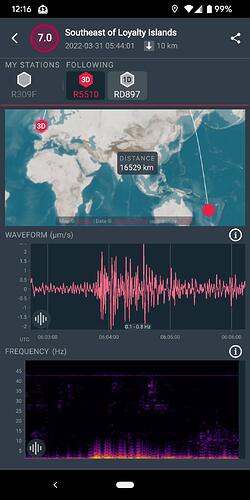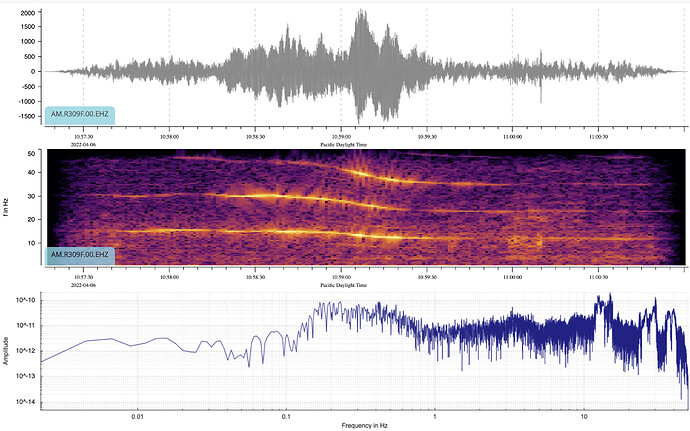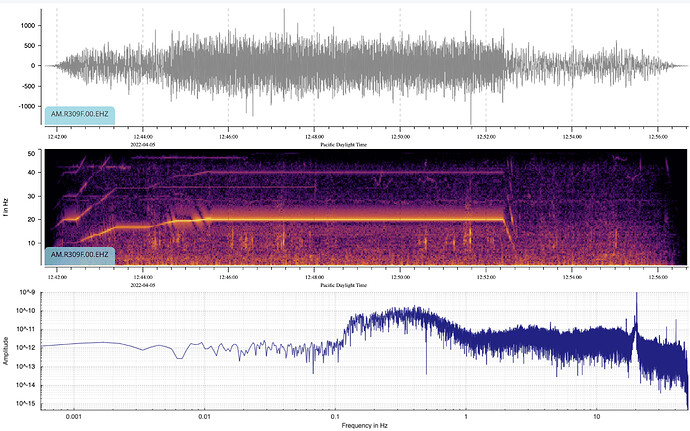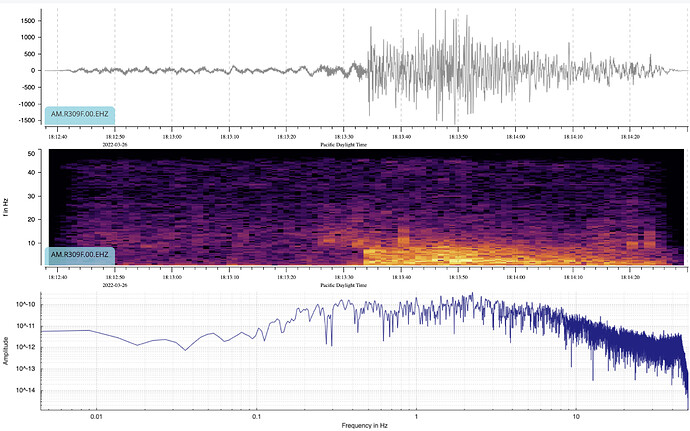Hello. I installed my RS3D (R5510) earlier this year and don’t seem to have recorded a single seism. I have attached a comparison of my Z sensor output with that of another shake (R6C8A), 22 km away from mine. He has plenty of seisms during the night (easy to recognise because there’s no ambient daytime noise), many of which can be interpreted in terms of P, S and Surface waves. The only activity on my shake is a vivit to the bathroom. I notice that there is a massive difference in the y axis scale between the two. Should I recalibrate my y axis, and if so, how? If it’s not that, what am I doing wrong, what should I do? Help, please! Pete Webb.
Comparison.docx (255.1 KB)
Your device appears to be working fine. From your data, via dataview web page, I see this:
That is the magnitude 7.0 earthquake that happened in the Loyalty Islands (just East of Australia), 16,529km from you. I did have to apply a filter (0.7, 5.0) to separate it out of the noise, but the fact that it is there tells me things are working fine.
Looking at the data on R6C8A for the times you mention, they look to me like local “bumps in the night”, and don’t have the profile of earthquakes.
The mobile app is also useful in checking to see if you recorded specific earthquakes:
Hello petewebbgeo,
Thank you for contacting us about this. I would agree with Philip, all the “bumps” that can be seen on the R6C8A seismometer are not earthquakes, but local noise that starts early in the morning and ends around midnight, probably part of the daily cycle of activities of your area.
Furthermore, there has not been an earthquake in the British Isles in the time period you have displayed in the comparison except for this one:
2022/03/31 20:55:59.6 51.939 -2.982 13 M0.5 CLODOCK,HEREFORDSHIRE
But, being an M0.5, it is unlikely that the Shakes have captured it, even if the distance was close.
On the other side, the M7.0, and other stronger far away quakes that have happened in the recent past have been successfully captured by your instrument, as also Philip has shown.
I would also advise using our Android/iPhone ShakeNet App to start navigating this very interesting world of earthquake detection, how to use filtering to eliminate local noise and make distant quakes “pop up” in your data stream, and, consequently, do the same on your PC via SWARM or our DataView service.
If you need further assistance, both the community and I are here.
Many thanks to you both, Philip and Stormchaser. Your explanation was very clear. I converted Pacific Daylight Time to British Summer Time and found the Loyalty Islands quake on my shake, attached. In fact, I was aware of that quake (and about 12 others there subsequently) because I get notifications of anything over M 5 from the USGS - about 12 a day (164.9 KB) One question: my shake is freestandjng on a tiled floor, ground floor. Does it need to be cemented in place? The fact that you both think the device is working fine suggests I don’t need to do that. Best regards, Pete.
For what it is worth, mine is free-standing on a concrete floor and seems to be working fine like that.
I believe that is how it was designed to work.
Hello petewebbgeo,
Yes, as Philip said, there is no need to solidly anchor your Shake to the floor. That particular setup is recommended only if you live in an earthquake-active area (such as California, for example) and/or you have bought our RS4D model, which is the only one that has an anchoring point integrated into its case.
Mine is simply standing on the lower shelf of my library, and even if it is a noisy location compared to a seismic vault outside, it manages to capture most M6+ world events.
I was wondering what the daytime “noise” you are seeing was. I was thinking that out there in the edge of the Pennines it should be pretty quiet. But Google Earth shows the Arden Quarry looking pretty active. So I am guessing that is a big part of that “noise”.
I have some building work going on about a mile from me. When they were doing the excavation, pipe and sewer laying it was quite noticeable. Even the construction activity shows…
I find trying to relate some of the stuff that is captured to what caused it. It increases the interest between earthquakes 
I can tell helicopters from the bin lorry and the Amazon delivery truck.
I’m pleased about that, I wasn’t looking forward to drilling holes in the tiles that my wife chose.
I assume that much of the daytime noise I was referring to is the wife and me moving around the house, so not much traffic along the road, and we’re 40 m back from that. We live near the end of a cul-de-sac beyond which is farming land and then moorland. The village is small and quiet. We’re on the flight path into Manchester Airport, and I recorded a plane overhead yesterday, attached, but it’s not much over background.
Arden Quarry (2 km from my hoAeroplane noise.docx (32.0 KB) use) is not an active Quarry any more, it’s a landfill site. The only activity there is heavy lorries in and out and bulldozers and graders flattening out all the rubbish, no blasting.
The Google Earth photo of the quarry shows some big diggers in action there. Looking at it again, landfill does make more sense.
Aircraft seem to be hard to pick out. They don’t rattle the windows and shake the ground like helicopters.
We get big, twin rotor ones, mostly forestry, occasional military. You can tell these from the spectrogram, with three frequencies showing up:
Single rotor ones often have just a single trace, sometimes two when the tail rotor shows up.
The other one that puzzled me for a while is the spin cycle on our washing machine - it’s 30m away from the seismometer, but still gives a clear trace:
These are very different from an eathquake - example M5.0 500km away, out to sea:
Low frequency noise, often with a very sharp leading “edge” as whatever is under tension finally slips.
Of course, I picked out the clear, easily identifiable ones here …
As mentioned before, for earthquakes, it’s hard to beat the mobile app.
Thank you, that’s an interesting set of images. Re the 31 March/01 April (depending on the tine zone) M 7 quake in the Loyalty Islands, I no longer have the USGS noitification, can you tell me its UTC time at the epicentre, please?
I no longer have it either - but take a look at the screenshot of the mobile app above – at the top, it has the local time of the 'quake in UTC, and on the seismograph, it has the time of arrival at your location, in UTC.
Brilliant! Thanks very much. It took that quake 29.5 minutes to reach my shake. I can use that as a first pass for other quakes in the same region, and there seems to be quite a few of them.
Yes, there are. That area seems to be very active currently.
But remember that this is a logarithmic scale, so dropping just a little bit in Richter Scale intensity is a pretty big drop in actual energy, so those less intense 'quakes may not make it above noise level the other side of the world.
But still, worth experimenting with different filter settings to see how many of them you can actually pick out.
The mobile app is really worth playing with. It lists all the quakes, world-wide, and displays your device data (or any other device you choose), calculates the expected arrival time of the P and S waves and marks them on your data, and applies a good starting-point set of filters baed upon the distance, so just by clicking on a given earthquake, you can see if it was recorded by your device. You may be able to dig out signals not displayed by using your own filter parameters, but it seems like 99% of the time, if you don’t see it pulled out by this app, you are not going to see it.
I hope that all this functionality makes it into the web application - it’s just so much better with a bigger screen and proper keyboard/mouse.
The Kermadec Trough, on the same plate bloundary, is also pretty active.
Re the app, my phone’s Play Store came up with several raspberry apps. Which one do I need?
The one appropriate for your phone listes towards the top of this page:
Android: https://play.google.com/store/apps/details?id=org.raspberryshake.app
iPhone: ShakeNet on the App Store
That worked, I now have a phone full of quakes. Is the time recorded the time of the event, UTC? I also noticed that some of the quakes had the same waveform and frequency spectrum, why is that?
Hello petewebbgeo,
Yes, all the times for all the quakes and signals on all our services (except on DataView, where we offer both UTC and local PC time) is UTC, which is the standard format used for earthquake data transmission and exchange.
Regarding your second question, could you expand more on what you mean about some of the quakes had the same waveform and frequency spectrum? Thank you.
Thanks, I thought it was UTC.
Re “some of the quakes had the same waveform and frequency spectrum”, I’ve now looked a bit more closely and switched filters, and can see that they are superficially similar but not in detail. I was looking at quakes before I had got up this morning, and think that what I was seeing was background noise, which at that time of day is pretty well constant, hence the apparent similarity.
I’ve also noticed that the display on my phone for a M 4.6 quake in Peru listed at 06.28.58 UTC runs from 06.40.27 to 06.44.00. Is that 12 minute time lag what RS reckons to be the travel time from Peru to my R5510? There is indeed a sharp spike at 06.40.30 on the app display, but I don’t think it’s the Peru quake, as on my shake helicorder, there is a series of sharp spikes between 06.40.00 and 06.40.30, just about when I was going into the kitchen. As you already observed, M is logarithmic, so the Peru quake at 4.6 is around several hundred times weaker than the Loyalty Islands M 7.0 (6.8 according to the USGS) and might not show up 9686 km away.
You’re right about the app! I’m starting to enjoy this now and shall be looking out for something of a decent size nearer to the UK!
Keep an eye on rhe StationView page: RS StationView
There isn’t a lot of activity really close to the UK, but if you look you will see that there was a M4.7 in Poland on the 7th, and a M4.6 on the 11th, south of Iceland, West of Ireland.
The mobile app also has a setting to sort the 'quakes by distance, and by “relevance”, those can be useful too.




